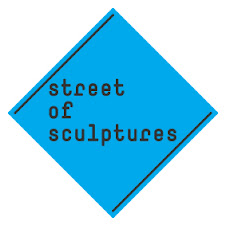18 December 2007
African Click
17 December 2007
Meeting Stijn Huijts
Today I travelled to the south of the Netherlands to meet Stijn Huijts, one of three programme committee members. Martijn van Nieuwenhuijzen (Curator at the Stedelijk Museum) and Jeroen Boomgaard (Associate Professor Art and Public Space at the Rietveld Academy) are the other two members. The programme committee advises the Board of the Foundation Street of Sculptures on art-related matters. It is involved in the selection of the curator (well, after me that is. There was no programme committee when I took the job), evaluates the project plan of the curator, and assists the curator with the evaluation of the sketches. But it also functions as a sounding board for the curator. At least, that’s what I do.
Stijn is very much informed about the latest trends and the newest talents, not just in the Netherlands, but internationally. Stijn has just changed jobs. He was the director of het Domein in Sittard. Now he is the director of the Glaspaleis in Heerlen. The Glaspaleis is a fantastic building from the 1930s that still feels very contemporary. It houses a library, an architectural centre, a art centre, a music school and a cinema. Stijn is a man with a vision and a mission. I think it will be good to keep track of all the things that will happen here over next years.
06 December 2007
A virtual Street of Sculptures
01 December 2007
Surprise dinner
Food was great and that always helps getting the conversation going. Contemporary art in Turkey, the political situation (Halil has a Kurdish background), Sinan (Ton is a big fan), and Turkmenistan (Nienke had just seen Shadow of the Holy Book at the IDFA) were just a few of the topics.
Half way through the evening, Halil surprised us all by presenting his proposal for Open Source Amsterdam – sorry, can't reveal anything yet; you’ll have to wait until April 2008. All I can say is that I am delighted!
30 November 2007
Rijksakademie
Halil & Azra
Later that day we went to the Bijlmer. Unfortunately, the weather was dismal. So we decided not to walk the whole route (3 km), but to take the car and make 4 stops: one around the newly opened Bijlmer Station and the shopping centre Amsterdamse Poort; one at the Anton de Komplein; one at the Gulden Kruispad along a canal, which has a lovely rural feel; and finally at the metrostation Kraaiennest. Halil didn’t disclose anything, but I have a feeling that he too (just like Thomas Hirschhorn) will prefer the area around Kraaiennest.
28 November 2007
27 November 2007
Visa update 1
Well, I e-mailed and faxed 8 pages to the Consulate General i n Istanbul, to both the visa and cultural affairs department. I have sent:
1. A letter to the consulate asking politely for a speedy procedure;
2. A letter of invitation, stating we will pay for everything, accept full responsibility and will compensate all costs in case our invitee is deported;
3. Flight details and proof of a return flight;
4. Hotel reservation;
5. Information about our organisation, the foundation Street of Sculptures (including all the important names on our recommendation committee);
6. Information about Open Source Amsterdam;
7. List of artists participating in Open Source Amsterdam;
8. Letter of invitation for participation in the project.
I hope this will convince the people at the consulate. Let’s hope for the best, prepare for the worst.
26 November 2007
Welcome to the Netherlands
Halil is one of our participating artists. Halil is also a curator and a publisher of magazines and books on contemporary Turkish art. I admire him immensely: his career took off like a rocket, exhibiting at the Istanbul Biennial (1997), the Sao Paolo Biennial (1998), Gwangju Bienniale (2002) and Manifesta 4 (2002). Then he decided to stay in Istanbul and set up an underground art scene as a reaction to the commercialisation of art in Turkey the last couple of years. He now chooses his foreign adventures very carefully, like Documenta 12 (see video still above). You can imagine how pleased I am he will create a work for us.
Azra is an art critic writing for Radikal, a Turkish daily. She is Halil’s girlfriend and comes along as a translator since Halil’s English is not that good and my understanding of Turkish in zero.
Halil, luckily, has a long-term multi-entry Schengen visa. Azra does not. The Netherlands does not provide cultural visas, so we have to apply for a business visa. I checked the website of the Dutch Consulate General in Istanbul and it lists 12 documents that should be handed in. And it can take up to 2 months to process the application. Humph. The red tape and the lack of hospitability of the Netherlands is an embarrassment to me and our organisation.
16 October 2007
Thomas Hirschhorn
14 October 2007
Tate Modern
13 October 2007
Zoo Art Fair
12 October 2007
Frieze update 2
Just got a call from the gallery. I have a meeting tomorrow morning at one of their branches in town. Shouldn't party too hard tonight!
Frieze update 1

Getting more to terms with the commercial side of the art world. Everybody is here, not so much to buy works of art (although that too of course) but to meet people you'd otherwise have to go see in Parijs, Berlin, New York or Tokyo. I am getting more and more into the frantic, gossipy, money-crazy vibe that typifies the Frieze.
















